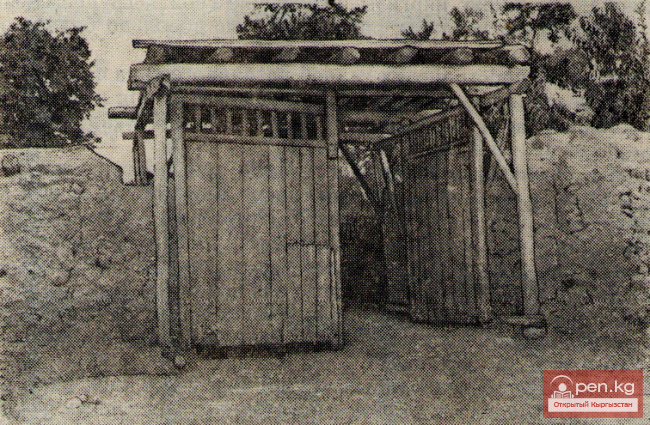
In the early 20th century, Kyrgyz people also built houses similar to the described type, but...

Settlements and Permanent Housing The 19th century was a turning point in the life of the Kyrgyz....

SETTLEMENT AND DWELLING The presence of two different types of economic activities in the 19th and...

The Influence of Other Peoples on the Craftsmanship of Kyrgyz The builders of Kyrgyz houses in the...

The clothing of the southern Kyrgyz has not received special attention in literature. There are...

Sedentary Life among the Kyrgyz The transition to sedentary life, being an extremely complex...

In the history of the economy of southern Kyrgyzstan, the 19th century was a turning point: they...

Outbuildings Outbuildings in southern Kyrgyzstan are quite uniform, but there are many variations...

The production of felt used to occupy a significant place in home industry. In the 19th century,...

Three Methods of Wall Construction among the Kyrgyz When starting to describe the types of houses...

Kyrgyz Settlements The character of the settlement, as well as the dwellings themselves, shows...

Sample of patterned fabric 'besh keshté'. Nookat District. The most vibrant and colorful...

Among the ready-made items purchased by Kyrgyz people, in addition to light robes, were quilted...

House with a high gable roof. Aksy District. Fergana and Mixed Types of Houses. While the spread...

The third type is a manor without a yard and fence, although the area in front of the house is...

Among other domestic crafts, weaving held one of the primary places among the Kyrgyz in the past....

Teshik and Eshik In the homes of Southern Kyrgyzstan, it is not difficult to trace the evolution...

Localization of the tribal groups of Kyrgyz...

Yurt of the Laylak District (above), yurt of the Alay Valley (below). Motifs of the appliqué...

The houses-manors are characterized by their close proximity to each other. Sometimes they adjoin...

Embroidery of the Southern Kyrgyz Southern Kyrgyz embroidery is the result of centuries of...

Wall Niches Wall niches are one of the characteristic features of the dwellings in Uzbekistan,...

A significant place in the decoration of felt products among the Kyrgyz is occupied by appliqué....

Construction Techniques The archaic types of stationary dwellings of the Kyrgyz include small...

The dominant type of dwelling in the conditions of centuries-old nomadic life of the Kyrgyz was...

The territory of the Osh region occupies the southwestern part of Kyrgyzstan. Its area is 75.5...

Metal Production and Artistic Metalworking The production of metal products among the Kyrgyz is...

The Artistic Creativity of Kyrgyz Women At first glance, one might get the impression that the...

The production of pile carpet products among the Kyrgyz was closely linked to the needs of a...

Gates of a closed-type estate. Batken district. The second type of estate is the closed-type...

Excerpt from the work of Abu-l-Ghazi (1603—1664) — almost a retelling from Rashid ad-Din's...

Housing. The new Constitution of the USSR was one of the first in the world to proclaim the right...

Pile weaving has long been known to the Kyrgyz living in the territory of the modern Osh region,...

The Decoration of Southern Kyrgyz Dwellings A prominent role in the decoration of the living room...

Distribution area of the Kyrgyz...

Tamuy - a mud yurt in the yard on kыштоо (wintering) and buursun - a wooden plow. The village of...

The clothing that protects against the cold in winter and at high altitudes in the mountains for...

Artistic Crafts: Traditions and Modernity The decorative and applied arts of various territorial...

Kyrgyz Woodworking Masters Woodworking masters also make musical instruments (Fig. 84) from...

Silver Jewelry Among the Kyrgyz In the past, Kyrgyz jewelers widely used the technique of inlaying...

Using the technique of rolled colored pattern, a felt carpet is made, which has the original name...

Roofing of Houses The construction of the walls of the house is preceded by the laying of the...

Fabrics of Kyrgyz production are characterized by plain weave, which is considered the simplest...

In the nomadic lifestyle of the Kyrgyz, wool found wide application. Wool products and materials...

The men's outerwear known as a robe is characterized by great diversity. In the past, it was...

Population of Kyrgyzstan Thanks to the fundamental changes that occurred in Kyrgyzstan after the...